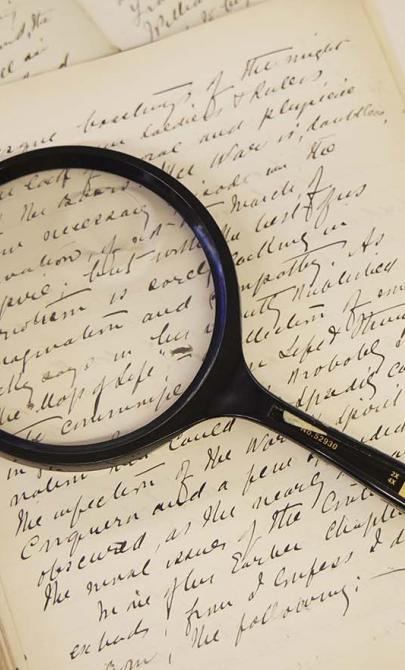Pickering Collection
Key items in the collection
Highlights from this collection demonstrate its historical significance and variety.
The Pickering Collection comprises about 440 titles (650 volumes) published by William Pickering between 1820 and 1854. They include 152 books that were not seen by Geoffrey Keynes when he compiled William Pickering: A Memoir and a Handlist of his Editions (1924).
The following titles illustrate the range of the Pickering Collection:
- Hans Christian Andersen, Danish Fairy Legends and Tales (1846)
- Francis Bacon, The Works of Francis Bacon, Lord Chancellor of England (16 vols, 1825–1834)
- Jeremy Bentham, A Fragment on Government, or a Comment on the Commentaries (1823)
- François Bernier, Travels in the Mogul Empire, A.D. 1656–1668 (1826)
- The Book of Common Prayer (1844)
- Samuel Taylor Coleridge, Aids to Reflection in the Formation of a Manly Character on the Several Grounds of Prudence, Morality and Religion (1836)
- Alexander Dyce, Specimens of English Sonnets (1833)
- Thomas Fuller, The History of the Holy War (1840)
- Robert Greene, The Dramatic Works of Robert Greene, to Which are Added his Poems (2 vols, 1831)
- George Herbert, Works (2 vols, 1846)
- Horace, Quintus Horatius Flaccus (1824)
- Edward Jupp, An Historical Account of the Worshipful Company of Carpenters of the City of London (1848)
- Thomas à Kempis, De imitatione Christi: libri quattuor (1827)
- Samuel Meyrick, Specimens of Ancient Furniture Drawn from Existing Authorities by Henry Shaw (1836)
- John Milton, The Poetical Works of John Milton (3 vols, 1826)
- JD Morell, Elements of Psychology (1853)
- Grenville Pigott, A Manual of Scandinavian Mythology (1839)
- William Roberts, History of Letter Writing, from the Earliest Period to the Fifth Century (1843)
- William Shakespeare, Poems of William Shakespeare (1825)
- Henry Shaw, The Decorative Arts, Ecclesiastical and Civil, of the Middle Ages (1851)
- James Thomson, The Seasons (1830)
- Izaak Walton and Charles Cotton, The Complete Angler, or the Contemplative Man’s Recreation (1826).
The collection also has strong holdings of some of the series published by Pickering:
- Aldine Poets (50 vols, 1830–1853)
- Christian Classics (17 vols, 1847–1853)
- Diamond Classics (30 vols, 1821–1831)
- Small books on great subjects (23 vols, 1845–1852).
The set of the Aldine Poets is almost complete – in his bibliography Keynes identified 53 volumes.
About William Pickering
William Pickering (1796–1854) was apprenticed to a London bookseller and publisher in 1810.
Bookshop and early publishing ventures
In 1820, Pickering set up his own bookshop, specialising in the antiquarian trade, and immediately started publishing. His first major project was the miniature Diamond Classics, comprising reprints of Latin, Italian, Greek and English literature. They were followed by the Oxford English Classics and new editions of:
- Edmund Spenser
- John Milton
- Francis Bacon
- William Shakespeare.
In 1828, he met Charles Whittingham, who was to be his chief printer, and in the same year he adopted the dolphin and anchor device used by the Venetian printer Aldus Manutius (1449–1515). In 1830 he began publishing the Aldine Edition of British poets.
Key literary works and influential authors
As well as reprints of classics, Pickering published modern writers such as:
- ST Coleridge
- Jeremy Bentham
- Thomas Malthus
- Coventry Patmore
- Edward Fitzgerald.
He had a strong attachment to the Anglican Church and published editions of 17th-century divines and The Book of Common Prayer (1844).
Innovations in bookbinding and typography
Pickering also published journals, such as the Gentleman's Magazine and the Church of England Quarterly Review. His poor business practices eventually led to bankruptcy and he was forced to sell his stock shortly before his death.
Quintus Horatius Flaccus, which Pickering published in 1820, was one of the first English books to be issued with a binding of dyed cotton cloth with a printed label on the spine. The Poetical Fragments of Richard Baxter (1821) was bound in the same way and he followed the practice throughout his career. Although imitated by other publishers, the smooth cloth used by Pickering remained the distinguishing mark of his books. The cloth was available in the following colours:
- red
- magenta
- puce (dark reddish-brown or purplish-brown)
- dark blue.
The collection adds significantly to the Library's holdings in English and classical literature and, because of innovations Pickering introduced in typography, format and binding, will be of value to those scholars interested in book production.
Background to the collection
The Pickering Collection was assembled by Harold S Lindfield, a bookseller from Worcester Park, Surrey.
The Pickering Collection was purchased from the London fine art and library agents, Stevens and Brown, in 1961.
The Pickering Collection is kept together as a formed collection within the Rare Books Collection. It is located at RB 655.142 PIC. The books have been catalogued individually. Catalogue cards for the 152 books in the collection that were not listed in Keynes' handlist have been photocopied and bound. The volume is held at N 016.655442 P596K.
This guide was prepared using these references:
- Geoffrey Keynes, William Pickering: A Memoir and a Handlist of his Editions, Chiswick Press, London, 1924.
- AL Munby, The Sales of William Pickering's Publications, The Book Collector, vol 21 (1), Spring 1972, pp 33–9.
- Bernard Warrington, William Pickering, Oxford Dictionary of National Biography, vol 44, Oxford University Press, Oxford, 2004, pp 217–18.




